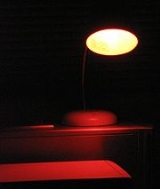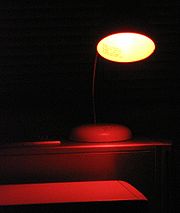
Safelight
Encyclopedia

Visible spectrum
The visible spectrum is the portion of the electromagnetic spectrum that is visible to the human eye. Electromagnetic radiation in this range of wavelengths is called visible light or simply light. A typical human eye will respond to wavelengths from about 390 to 750 nm. In terms of...
to which the photographic material in use is nearly or completely insensitive.
Design
A safelight usually consists of an ordinary light bulb in a housing closed off by a coloured filterFilter (optics)
Optical filters are devices which selectively transmit light of different wavelengths, usually implemented as plane glass or plastic devices in the optical path which are either dyed in the mass or have interference coatings....
, but sometimes a special light bulb or fluorescent tube with suitable filter material coated directly on the glass is used in an ordinary fixture.
Differently sensitised materials require different safelights. In traditional black-and-white
Black-and-white
Black-and-white, often abbreviated B/W or B&W, is a term referring to a number of monochrome forms in visual arts.Black-and-white as a description is also something of a misnomer, for in addition to black and white, most of these media included varying shades of gray...
photographic printing, photographic paper
Photographic paper
Photographic paper is paper coated with light-sensitive chemicals, used for making photographic prints.Photographic paper is exposed to light in a controlled manner, either by placing a negative in contact with the paper directly to produce a contact print, by using an enlarger in order to create a...
s are normally handled under an amber or red safelight, as such papers are typically sensitive only to blue and green light. Orthochromatic
Orthochromatic
- Orthochromatic photography :Orthochromatic photography refers to a photographic emulsion that is sensitive to only blue and green light, and thus can be processed with a red safelight. The increased blue sensitivity causes blue objects to appear lighter and red ones darker...
papers and films are also sensitive to yellow light and must be used only with a deep red safelight, not with an amber one. Panchromatic
Panchromatic
Panchromatic film is a type of black-and-white photographic film that is sensitive to all wavelengths of visible light. A panchromatic film therefore produces a realistic reproduction of a scene as it appears to the human eye. Almost all modern photographic film is panchromatic, but some types are...
films and papers, nominally sensitive to the entire spectrum, sometimes have a region of minimum in their range of sensitivity which allows the careful use of safelight confined to that part of the spectrum, e.g., Kodak Panalure panchromatic paper, tolerant of limited exposure to light filtered through a Kodak 13 Safelight Filter. Other panchromatic materials must be handled only in total darkness.
Many photosensitive materials used in technical and industrial applications, such as photoresist
Photoresist
A photoresist is a light-sensitive material used in several industrial processes, such as photolithography and photoengraving to form a patterned coating on a surface.-Tone:Photoresists are classified into two groups: positive resists and negative resists....
, are sensitive only to blue, violet and ultraviolet light and may be handled under a brighter yellow safelight. Low-pressure sodium vapor lamps are sometimes used in larger industrial darkrooms. They emit nearly monochromatic light at 589 nm (yellow), to which the materials are insensitive; as a result they can be extremely bright while still "safe".
The word "safe" in "safelight" is relative, as in most cases a sensitised material will eventually be affected by its safelight if
exposed to it for an extended length of time.

